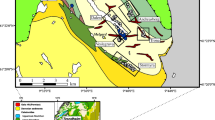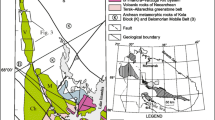Abstract
The Tamarack magmatic sulfide deposit is hosted by the Tamarack Intrusive Complex (1105.6 ± 1.2 Ma) in the Midcontinent Rift System. The most important sulfide mineralization in the Complex occurs in the northern part, which consists of two separate intrusive units: an early funnel-shaped layered peridotite body containing relatively fine-grained olivine (referred to as the FGO Intrusion) at the top, and a late gabbro-troctolite-peridotite dike-like body containing relatively coarse-grained olivine (referred to as the CGO Intrusion) at the bottom. Disseminated, net-textured, and massive sulfides occur in the base of the FGO Intrusion as well as in the upper part of the CGO Intrusion. The widest part of the CGO Intrusion also hosts a large semi-massive (net-textured) sulfide ore body locally surrounded by disseminated sulfide mineralization. Small massive sulfide veins occur in the footwall of the FGO Intrusion and in the wall rocks of the CGO dike. The sulfide mineralization is predominantly composed of pyrrhotite, pentlandite, and chalcopyrite, plus minor magnetite. Pyrrhotite containing the highest Ni and Co contents occurs in the FGO disseminated sulfides and in the CGO semi-massive sulfide ores, respectively. The most important platinum-group minerals associated with the base metal sulfides are sperrylite (PtAs2), sudburyite (PdSb), and michenerite (PdBiTe). Nickel shows a strong positive correlation with S in all types of sulfide mineralization, and Cu shows a strong positive correlation with S in the disseminated sulfide mineralization. At a given S content, the concentrations of Pt, Pd, and Au in the CGO disseminated sulfides are significantly higher than those in the FGO disseminated sulfides. The semi-massive sulfide ores are characterized by significantly higher IPGE (Ir, Os, Ru, and Rh) concentrations than most of the massive sulfide ores. With few exceptions, all of the various textural types of sulfide mineralization collectively show a good positive correlation between Pt and Pd, and between individual IPGE. At a given Pt or Pd content, however, the semi-massive sulfide ores have higher IPGE contents than the disseminated sulfide samples. Modeling results show that the variations in PGE tenors (metals in recalculated 100 % sulfide) in the Tamarack magmatic sulfide deposit are mainly controlled by variable R factors (magma/sulfide-liquid mass ratios) during sulfide-liquid segregation and subsequent monosulfide solid solution (MSS) fractionation during cooling. The initial contents of Ir, Pt, and Pd in the parental magma, estimated from the metal tenors of the disseminated sulfides, are 0.2, 2, and 1.8 ppb, respectively, which are ∼1/5 of the values for the PGE-undepleted primitive basalts of the Midcontinent Rift System. The variations of PGE tenors in the semi-massive and massive sulfide ores can be explained by MSS fractional crystallization from sulfide liquids. Extreme variations in the PGE contents of the massive sulfides may also in part reflect metal mobility during post-crystallization hydrothermal processes. The higher PGE tenors for the disseminated sulfides in the CGO dike relative to those in the FGO Intrusion are consistent with formation in a dynamic conduit where the early sulfide liquids left in the conduit by the FGO magma were subsequently upgraded by the subsequent surge of the CGO magma. The relatively low PGE tenors for the semi-massive and massive sulfides can be explained by lack of such an upgrading process for the sulfide due to their distal locations in a migrating conduit.












Similar content being viewed by others
References
Andrews MS, Ripley EM (1989) Mass transfer and sulfur fixation in the contact aureole of the Duluth Complex, Dunka Road Cu-Ni deposit, Minnesota. Can Mineral 27:293–310
Barnes S-J, Lightfoot PC (2005) Formation of magmatic nickel sulfide deposits and processes affecting their copper and platinum group element contents. In: Hedenquist JW, Thompson JFH, Goldfarb RJ, Richards JP (eds) Economic geology 100th anniversary volume. Society of Economic Geologists, Littleton, pp 179–213
Barnes S-J, Boyd R, Korneliussen A, Nilsson LP, Often M, Pedersen RB, Robins B (1988) The use of mantle normalization and metal ratios in discriminating between the effects of partial melting, crystal fractionation and sulphide segregation on platinum-group elements, gold, nickel and copper: examples from Norway. In: Prichard HM, Potts PJ, Bowles JFW, Cribb SJ (eds) Geo-platinum 87. Springer, Netherlands, pp 113–143
Campbell IH, Naldrett AJ (1979) The influence of silicate:sulfide ratios on the geochemistry of magmatic sulfides. Econ Geol 74:1503–1506
Ding X, Li C, Ripley EM, Rossell D, Kamo S (2010) The Eagle and East Eagle sulfide ore-bearing mafic-ultramafic intrusions in the Midcontinent Rift System, upper Michigan: geochronology and petrologic evolution. Geochem Geophys Geosyst Q03003. doi:10.1029/2009GC002546
Ding X, Ripley EM, Li C (2012) PGE geochemistry of the Eagle Ni-Cu-(PGE) deposit, Upper Michigan: constraints on ore genesis in a dynamic magma conduit. Mineral Deposita 47:89–104
Goldner BD (2011) Igneous petrology of the Ni-Cu-PGE mineralized tamarack intrusion, Aitkin and Carlton counties, Minnesota. Unpublished MSc thesis, University of Minnesota, Duluth, pp 155
Jirsa MA, Lively RS, Robinson L (2011) Geologic map of Minnesota: bedrock geology. Minnesota Geological Survey. University of Minnesota, St Paul
Keays RR, Lightfoot PC (2015) Geochemical stratigraphy of the Keweenawan Midcontinent Rift volcanic rocks with regional implications for the genesis of associated Ni, Cu, Co, and platinum group element sulfide mineralization. Econ Geol 110:1235–1267
Kerr A, Leitch AM (2005) Self-destructive sulfide segregation systems and the formation of high-grade magmatic ore deposits. Econ Geol 100:311–332
Lesher CM, Campbell IH (1993) Geochemical and Fluid Dynamic Modeling of Compositional Variations in Archaean Komatiite-hosted Nickel Sulfide Ores in Western Australia: Economic Geology and the Bulletin of the Society of Economic Geologists, 88(4):804–816
Li C, Naldrett AJ (1999) Geology and petrology of the Voisey’s Bay Intrusion: reaction of olivine with sulfide and silicate liquids. Lithos 47:1–31
Li C, Ripley EM (2009) Sulfur contents at sulfide-liquid or anhydrite saturation in silicate melts: empirical equations and example applications. Econ Geol 104:405–412
Li C, Ripley EM (2011) The giant Jinchuan Ni-Cu-(PGE) deposit: tectonic setting, magma evolution, ore genesis, and exploration implications. Rev Econ Geol 17:163–180
Li C, Barnes SJ, Makovicky E, Rose-Hansen J, Makovicky M (1996) Partitioning of nickel, copper, iridium, rhenium, platinum, and palladium between monosulfide solid solution and sulfide liquid: effects of composition and temperature. Geochim Cosmochim Acta 60:1231–1238
Lightfoot PC, Keays RR, Evans-Lamswood D, Wheeler R (2012) S saturation history of Nain plutonic suite mafic intrusions: origin of the Voisey’s Bay Ni-Cu-Co sulfide deposit, Labrador, Canada. Mineral Deposita 47:23–50
Lucente ME, Morey GB (1983) Stratigraphy and sedimentology of the lower Proterozoic Virginia Formation, northern Minnesota. Minnesota Geological Survey Report of Investigations, St Paul, Minnesota, Volume 28. pp 28
Miller JD, Green JC, Severson MJ, Chandler VW, Hauck SA, Peterson DM, Wahl TE (2002) Geology and mineral potential of the Duluth Complex and related rocks of northeastern Minnesota. Minnesota Geological Survey Report of Investigations, St Paul, Minnesota, Volume 58. pp 207
Miller JD, Nicholson SW, Easton RM, Ripley EM, Feinberg JM (2013) The geology and mineral deposits of the 1.1 Ga midcontinent rift in the lake superior region—an overview. In: Miller JD (ed) Field guide to the copper-nickel-platinum group element deposits of the lake superior region, precambrian research center guidebook 13–01. p 1–50
Mungall JE, Brenan JM (2014) Partitioning of platinum-group elements and Au between sulfide liquid and basalt and the origins of mantle-crust fractionation of the chalcophile elements. Geochim Cosmochim Acta 125:265–289
Mungall JE, Andrews DRA, Cabri L, Sylvester PL, Tubrett M (2005) Partitioning of Cu, Ni, Au and platinum-group elements between monosulfide solid solution and sulfide melt under controlled oxygen and sulfur fugacities. Geochim Cosmochim Acta 69:4349–4360
Naldrett AJ (2010) Secular variation of magmatic sulfide deposits and their source magmas. Econ Geol 105:669–688
Naldrett AJ, Pessaran A, Asif M, Li C (1994) Compositional variation in the Sudbury ores and prediction of the proximity of footwall copper-PGE orebodies. Proceedings of the Sudbury-Noril’sk Symposium, Ontario Geological Survey Special Volume 5. pp 133–143
Naldrett AJ, Fedorenko VA, Asif M, Lin S, Kunilov VE, Stekhin AI, Lightfoot PC, Gorbachev NS (1996) Controls on the composition of Ni-Cu sulfide deposits as illustrated by those at Noril’sk, Siberia. Econ Geol 91:751–773
Ojakangas RW, Morey GB, Green JC, Eriksson PG, Catuneanu O, Aspler LB, Chiarenzelli JR, Martins-Neto MA (2001) The Mesoproterozoic midcontinent rift system, Lake Superior region, USA. Sediment Geol 141–142:421–442
Palme H, O’Neill H (2014) Cosmochemical estimates of mantle composition. In: Carlson RW (ed) The mantle and core, treatise on geochemistry, 2nd edn. Elsevier, New York, pp 1–39
Poulton SW, Fralick PW, Canfield DE (2010) Spatial variability in oceanic redox structure 1.8 billion years ago. Nat Geosci 3:486–490
Pufahl PK, Fralick PW (2004) Depositional controls on Palaeoproterozoic iron formation accumulation, Gogebic Range, Lake Superior region, USA. Sedimentology 51:791–808
Pufahl PK, Hiatt EE, Kyser TK (2010) Does the Paleoproterozoic Animikie Basin record the sulfidic ocean transition? Geology 38:659–662
Ripley EM, Li C (2011) A review of conduit-related Ni-Cu-(PGE) sulfide mineralization at the Voisey’s Bay Deposit, Labrador, and the Eagle Deposit, northern Michigan. Rev Econ Geol 17:181–197
Ripley EM, Li C (2013) Sulfide saturation in mafic magmas: is external sulfur required for magmatic Ni-Cu-(PGE) ore genesis? Econ Geol 108:45–58
Ripley EM, Li, CS (2003), Sulfur isotope exchange and metal enrichment in the formation of magmatic Cu-Ni-(PGE) deposits: Economic Geology and the Bulletin of the Society of Economic Geologists, 98(3):635–641
Ripley EM, Park Y-R, Lambert DD, Frick LR (2001) Re-Os isotopic composition and PGE contents of Proterozoic carbonaceous argillites, Virginia Formation, northeastern Minnesota. Org Geochem 32:857–866
Savard D, Barnes S-J, Meisel T (2010) Comparison between nickel-sulfur fire assay Te Co-precipitation and isotope dilution with high-pressure Asher acid digestion for the determination of platinum-group elements, rhenium and gold. Geostand Geoanal Res 34:281–291
Taranovic V, Ripley EM, Li C, Rossell D (2015) Petrogenesis of the Ni-Cu-PGE sulfide-bearing Tamarack Intrusive Complex, Midcontinent Rift System, Minnesota. Lithos 212–215:16–31
Theriault RD, Barnes S-J (1998) Compositional variations in Cu-Ni-PGE sulfides of the Dunka Road Deposit, Duluth Complex, Minnesota: the importance of combined assimilation and magmatic processes. Can Mineral 36:869–886
Tonnelier NJ (2010) Geology and genesis of the Jinchuan Ni-Cu-(PGE) deposit, China. Unpublished PhD thesis, Laurentian University, Sudbury, Ontario, Canada, pp 194
Van Schmus WR, Bickford ME, Zietz I (1987) Early and Middle Proterozoic provinces in the central United States. In: Kröner A (ed) Proterozic lithospheric evolution. American Geophysical Union, Washington DC. doi:10.1029/GD017p0043
Acknowledgments
We would like to thank Rio Tinto and Kennecott Exploration for providing funding for research expenses and for providing access to drill cores and exploration files; David Simpson of Rio Tinto for help with various phases of the research; Rio Tinto geologists, technicians, and staff at the Tamarack site; and the staff at the Hibbing core library for assistance with sampling of Tamarack drill cores. Constructive reviews from Tony Naldrett, Jim Mungall, and Michael Lesher are greatly appreciated.
Author information
Authors and Affiliations
Corresponding author
Additional information
Editorial handling: C.M. Lesher and G. Beaudoin
Electronic supplementary material
Below is the link to the electronic supplementary material.
Table S1
(XLSX 15 kb)
Rights and permissions
About this article
Cite this article
Taranovic, V., Ripley, E.M., Li, C. et al. Chalcophile element (Ni, Cu, PGE, and Au) variations in the Tamarack magmatic sulfide deposit in the Midcontinent Rift System: implications for dynamic ore-forming processes. Miner Deposita 51, 937–951 (2016). https://doi.org/10.1007/s00126-016-0643-2
Received:
Accepted:
Published:
Issue Date:
DOI: https://doi.org/10.1007/s00126-016-0643-2




